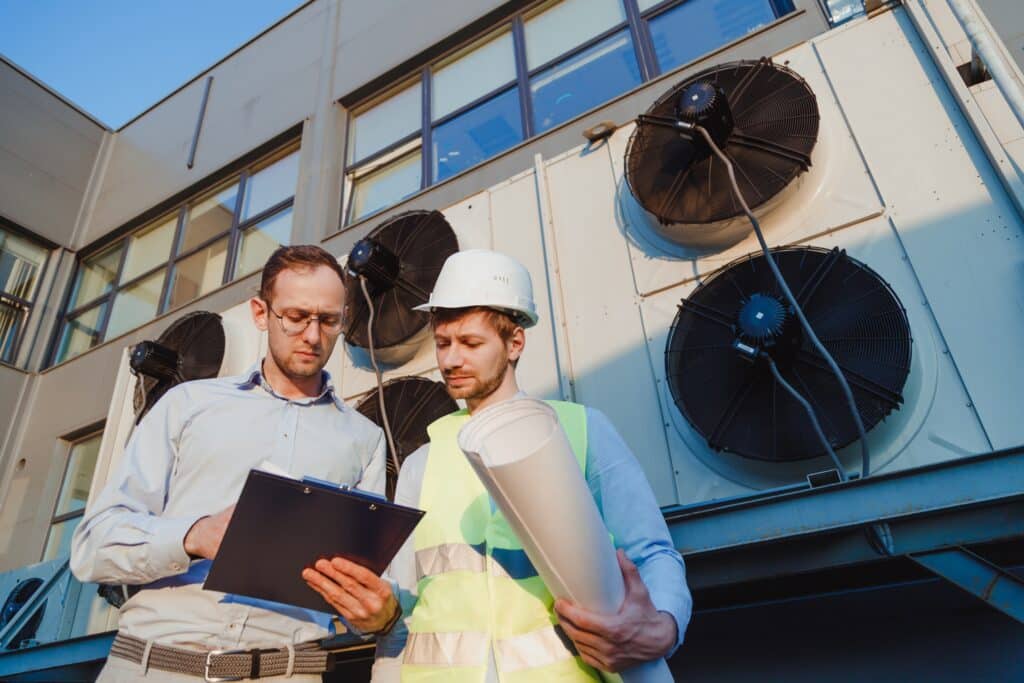Industrial Chillers, Uncategorized
Understanding the Refrigeration Cycle of Chillers
Chilling plays a vital role in a wide range of industries. From preserving food and pharmaceuticals to improving the results of medical imaging, the importance of refrigeration cannot be overstated.
Because so many of our modern tools create heat that leads to damage and inefficiency, cooling systems are necessary to reduce the impact of heat. Chillers are one of the most popular methods for controlling temperatures and ensuring that they remain at optimal levels.
More specifically, chillers use a refrigeration cycle to cool down their surroundings. In this blog, we will dive into the refrigeration cycle of chillers, explore their components and the role they play in the cooling process.
Basics of Refrigeration
The primary goal of any refrigeration system is to transfer heat from a lower-temperature region to a higher-temperature region—achieving cooling in the process.
While this may sound counterintuitive, refrigeration systems reverse the flow using the power of a refrigerant. A refrigerant is a type of fluid that has unique thermodynamic properties, which allow it to convert from a liquid to a gas and back again.
Components of a Chiller System
Chillers are composed of several components that vary depending on the type of chiller being used. These components include the following:
1. Evaporator
The evaporator is responsible for absorbing heat from the chilled water or process fluid. Located on the low-pressure side of the cycle, it facilitates the heat transfer process and provides the cooling effect required for the chiller’s operation.
Various types of evaporators, such as shell-and-tube and plate, are used in chillers to suit different applications.
2. Compressor
The compressor is the heart of the refrigeration cycle. It plays a crucial role in raising the pressure and temperature of the refrigerant vapor. The compressor enables the release of heat during the condensation process.
Chillers commonly use reciprocating, centrifugal, or screw compressors, each with its unique advantages in different scenarios.
3. Condenser
Located on the high-pressure side of the cycle, the condenser is responsible for rejecting heat from the refrigerant vapor to the surrounding environment. By removing heat, the refrigerant undergoes a phase change from a low-pressure vapor to high-pressure liquid form.
Commonly used condenser types include air-cooled, water-cooled, and evaporative condensers.
4. Expansion Device
The expansion device, typically an expansion valve, is positioned between the condenser and the evaporator.
Its primary function is to regulate the flow and pressure of the refrigerant, which causes it to undergo a sudden drop in pressure. This drop results in the refrigerant converting into a low-pressure liquid-vapor mixture. Then the refrigerant enters the evaporator to continue the cycle.
The Refrigeration Cycle in Chillers
So, how do chillers work? Chillers operate through a meticulously orchestrated refrigeration cycle consisting of four distinct stages that continuously repeat and facilitate effective cooling and optimal system performance. This refrigeration process serves to prolong the operational life of the system it chills and ensures its efficiency.
Step 1: Evaporation
The refrigeration cycle commences with the evaporator absorbing heat from the chilled water or process fluid. As the low-pressure liquid refrigerant enters the evaporator, it undergoes a phase change that transforms the refrigerant into a low-temperature vapor state. This vapor then absorbs heat from the surrounding environment and cools the water or fluid in the process.
Step 2: Compression
Following the evaporation phase, the low-temperature vaporized refrigerant enters the compressor, where a crucial transformation occurs. The compressor exerts substantial force on the refrigerant, elevating its pressure and temperature to levels suitable for the ensuing stage of the cycle. This compression process necessitates an input of energy, which is commonly derived from electricity or engine power.
Step 3: Condensation
At this stage, the high-temperature, high-pressure refrigerant vapor enters the condenser. Here, the heat amassed during the preceding evaporation and compression stages is released to the surrounding atmosphere or a designated cooling medium, such as water. The refrigerant undergoes a phase change back into liquid state in preparation for the forthcoming cycle.
Step 4: Expansion
Post-condensation, the high-pressure liquid refrigerant undergoes a rapid pressure reduction within the expansion device, typically implemented through an expansion valve. This swift reduction induces the conversion of the liquid into a low-pressure liquid-vapor mixture. The low-pressure refrigerant then returns to the evaporator, and the refrigeration cycle repeats.
The Bottom Line
Understanding the refrigeration cycle of chillers provides insights into the cooling process that drives various industries. The collaboration between the evaporator, compressor, condenser, and expansion device is fundamental to the efficient functioning of modern tools. Without chillers, your MRI machines and various applications would have a much shorter shelf life!
Find the Right Chiller for Your Industry
After decades of designing and providing chillers for businesses around the world, KKT Chillers is your source for reliable, efficient solutions. Our chillers are designed to meet the exact specifications and requirements of any industry, from medical imaging to industrial manufacturing. Contact us today to request a quote.
